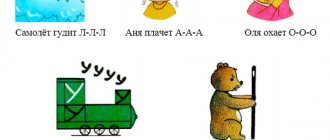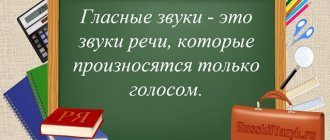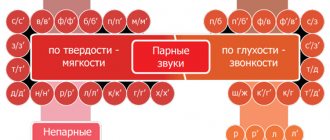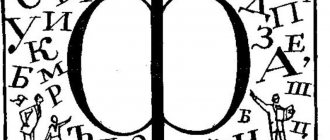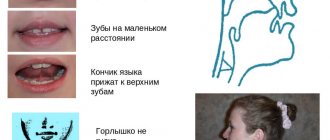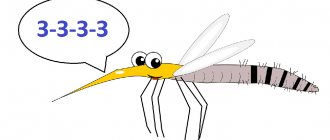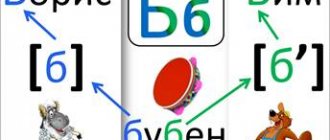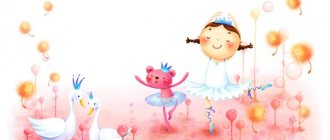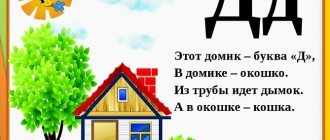Assignment: Printed letter M for preschoolers
- Look at the letter M. What does it look like?
- Form the letter M with your fingers.
- Write the letter M in the air.
Draw the sticks carefully along the cells with a simple pencil or ballpoint pen.
In cases where the child is asked to write a whole line of a letter, syllable or word, the adult gives a writing sample at the beginning of the line. If a preschooler has difficulties, then an adult can draw two approximate lines, or put reference points that the child will connect with lines, or write the entire letters, and the child will simply circle them in a different color. Calligraphy should not be required at this stage of training.
Print
Lesson notes - Sound and letter “M” for preschoolers with OHP
Synopsis of a frontal speech therapy session to prepare for literacy training for older children with special needs development.
Topic: SOUND AND LETTER “M”
TASKS:
Correctional and educational:
- learn to determine the first consonant sound, hardness - softness, sonority - dullness, position of sound in a word (beginning, end);
- consolidate the skills of clear pronunciation of the sound M, the concept of “syllable”;
- practice sound analysis and synthesis of syllables, dividing words into syllables;
- activate your verb dictionary.
Correctional and developmental: develop auditory attention, phonemic perception, articulatory and general motor skills, visual-motor coordination, memory, thinking.
Correctional and educational: cultivate a positive attitude towards classes; the ability to control one’s own speech; develop the skill of cooperation, the ability to listen to the interlocutor; cultivate respect for each other.
EQUIPMENT: pictures: girl Masha, cat Murka, flowers - daisies, poppies, tulips, asters, bells; semolina porridge and milk, pictures with and without sound M, capital letter M, mosaic, red and blue chips, sound track.
PROGRESS OF THE CLASS:
1. Go through the audio tracks, naming each vowel letter.
Today I want to tell you one amazing story about one amazing girl Masha. And she was amazing because every day she invented a new game for herself. So today Masha woke up, washed her face, did exercises and didn’t forget about her lips and tongue.
2. Articulation gymnastics.
a) Frogs smile - they pull their lips straight to their ears (“Smile” with closed lips); b) I imitate an elephant - I pull my lips with my trunk; c) The tongue is wide, smooth - it turns out to be a “scapula”
Today Masha thought: “This is the first sound I’ll hear, and I’ll be friends with it all day long.” Suddenly the cat Murka came running and started talking to Masha: “Mu-u-u-r-r..” Masha smiled - that means today I’m playing and making friends with the sound ... (which one, guys?) with the sound M.
3. Articulation and characteristics of the sound M
The lips are closed, the teeth are slightly open, the tongue lies calmly below. Consonant (there is a barrier - lips), firm, sonorous.
Masha went to the kitchen. Mom was preparing breakfast there. What kind of porridge did your mother cook, do you think: buckwheat, semolina or rice? Why? Masha went to the garden where the flowers grow, and sang songs along the way:
4. Reproduction of syllable rows: we-ma-mo, mo-we-mu, we-mo-ma... (everyone in turn helps Masha sing the song)
There were many flowers growing in the garden (pictures on the floor), but Masha chose flowers only with the sound M ( asters, daisies, bells, poppies, tulips ).
– What flowers should I pick? Why? (children's answers) What is a bouquet of poppies called if a bouquet of tulips is called a tulip bouquet? From poppies? ( poppy ), from daisies? ( chamomile ). Masha returned to the kitchen with flowers. And on the table there was already semolina porridge and milk . What was on the table? (semolina porridge and milk). Masha laughed: “Mommy, what a great fellow you are, you help me in my game.” - Why did Masha say that? Masha ate everything and said thank you. Now we will show Masha how we can play with sounds.
5. Sound analysis and synthesis of syllables.
Mark the syllables with chips: ma, om, mu.
Game "Live Sounds"
Masha took the book and began to look for pictures with the sound “m”. We also have pictures, take them under the chairs.
6. D/i “Find a picture with the sound “m.”
Determine where the sound M is at the beginning or end of the word. The one with the pictures with the sound M at the end, at the beginning, the pictures without the sound M will come out.
Let's divide the words you chose into syllables:
7. D/i “Divide the words into syllables” (children’s choice).
mu-ha - clap, ma-shi-na - stomp, mu-ho-mor - jump.
When dad returned from work, Masha talked about pictures with the sound “m” that she had been looking for all day. She also came across pictures - a fly , a car , a mouse . Dad asked what these objects do?
8. D/i “Choose an action word”
A fly flies, buzzes, bothers, sits, crawls... A car drives, stops, drives, drives in, drives out... A mouse squeaks, makes noise, gnaws, rustles, runs, jumps...
9. Introducing the letter.
Guys, we remember that we hear and pronounce sounds, but we see, read and write letters. So the sound “m” has its own letter “M”.
Stick and stick, Between them is a tick. And now it’s clear to everyone. The result is the letter “M”. Children lay out a letter from the mosaic.
10. Summary of the lesson.
What sound was there in class today? Is it a vowel or a consonant? Voiced or voiceless? Hard or soft?
PHYSICAL MINUTE (in the middle of the lesson) We use our hands - clap-clap-clap (6 times), We use our feet - stomp-stomp-stomp (6 times). Let's knock with our fists (6 times), turn around and remain silent (cover your mouth with your hand).
Anzhero - Sudzhensky urban district Municipal budgetary preschool educational institution combined type kindergarten No. 42 Author of the material: teacher-speech therapist: Levina Natalya Vladimirovna
Also on topic:
Summary of speech therapy lesson topic: Sounds M - M
Riddles for children starting with the letter M
The giant stands in the port, illuminating the darkness, and signals to the ships: “Come and visit us!” (Lighthouse)
Above the river, across. The giant lay down stretched out. Across the river, along the back. He allowed me to walk. (Bridge)
The owner of the forest wakes up in the spring, And in winter, to the howl of a blizzard, He sleeps in a snowy hut. (Bear)
In the forest near the stump there is running and bustling: The working people are busy all day, building a house for themselves. (Ants)
The red nose has grown into the ground, and the green tail is outside. We don't need a green tail, we only need a red nose. (Carrot)
He flies all day long, bores everyone; The night will come. Then it will stop. (Fly)
Crowded, noisy, young, the city rumbles underground. And there are houses with people running along the street. (Metro)
It slips away like something alive, But I won’t let it go. It foams with white foam, I’m not too lazy to wash my hands. (Soap)
What kind of artist applied leaves, grass, and thickets of roses to the glass? (Freezing)
Small stature, long tail, gray coat, sharp teeth. (Mouse)
A red-hot arrow felled an oak tree near the village. (Lightning)
Liquid, not water. White, not snow. (Milk)
The white pebble melted and left marks on the board. (Chalk)
Horned, but not butting. (Month)
Tale about the letter M
The mouse Mouse and the bear cub Misha were lying in the clearing and eating raspberries. The mouse says: “Let’s come up with poems.” Listen to what I wrote:
Every day and every hour we stubbornly repeat: There is no one in the world better than ours...
- Raspberries! - Misha yelled. - What does “raspberry” have to do with it! I wanted to say: “Better than our mother.” - That's great too! And now I’ll write... What about? - Well, at least about this fly agaric.
Don't eat white pasta, but eat red fly agarics!
- What are you, what are you! - The mouse was scared. “You can’t eat fly agarics, you’ll end up in the hospital.” Here, listen to the verse about the doctor:
There is no more important doctor in the forest than the lively redhead...
- Aibolit! - the bear cub yelled. - Yes, not Aibolit, but an ant. Aibolit heals animals, and the ant heals the forest. - How do you know so much? - He who reads a lot knows a lot! - the mouse Mouse answered importantly...
(G. Yudin)
Articulation and pronunciation of M
If we pronounce a word that contains such a sound, for example: ball, Masha, we will feel that the lips are slightly compressed, the tongue inside the oral cavity is moved back a little and even slightly pulled up to the upper palate with its middle part.
Then we feel the air begin to come out through the nose. A voice is heard, i.e. the sound is loud.
He doesn't have a partner, i.e. there is no sound similar to [m], but dull.
It can be pronounced firmly or softly. It depends on the letters next to the M.
Carrot - ball (hard - soft).
Remember: The letter M stands for the consonant sound [m]. It can be hard or soft, but it is always a labial nasal sonorant sound. The sound is softened by vowels - e, e, i, i and a soft sign: mint, chalk, bear, eight and others.
Continue the sentence
He slept all winter in a fur coat, sucked his brown paw, and when he woke up, he began to roar. This is a forest animal... (bear).
Look at the fellows: Cheerful and lively. Dragging from all ends Material for construction. One suddenly stumbled and a friend rushes to the rescue. The people here are good. Without work, for the life of me. Can’t live... (ant).
Lyudmila went to wash her hands. She needed... (soap).
Everyone here in the forest is talented - both a singer and... (musician).
Our Tanya is crying loudly. Dropped it into the river... (ball).
The distance of the fields turns green, the nightingale sings. The garden is dressed in white, The bees are the first to fly. Thunder rumbles. Guess what month this is? … (May.)
We put the puppy in water and soap for two hours with a washcloth... (washed).
Under a heavy burden - Underground, in a closet. She lives in a hole. Gray baby. Who is this? ... (mouse.)
In a black field, a white hare jumped, ran, and made loops. The trail behind him was also white. Who is this hare? … (chalk.)
